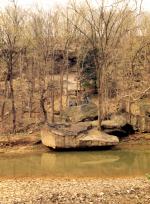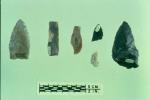![header=[Marker Text] body=[A deeply stratified archaeological site whose deposits span nearly 16,000 years of Pennsylvania's past. Discovered 1973; excavated by University of Pittsburgh archaeologists. Meadowcroft provides the oldest evidence of human presence in North America and the longest sequence of human occupation in the New World. All of eastern North America's major cultural stages appear in its remarkably complete archaeological record.] sign](http://explorepahistory.com/kora/files/1/10/1-A-1D8-139-ExplorePAHistory-a0h5a0-a_450.jpg)
Mouse over for marker text
Name:
Meadowcroft Rockshelter
Region:
Pittsburgh Region
County:
Washington
Marker Location:
401 Meadowcroft Rd., Avella
Dedication Date:
September 19, 1999
Behind the Marker
Like some private detectives, archaeologists spend much of their time sifting through other people's garbage. Sometimes, however, the other people have been dead thousands of years. When a group of archaeologists first showed up at the Meadowcroft Rockshelter site in 1973, they found beer cans and the remains of camp fires scattered around the site. A little bit of digging revealed more fire pits and older steel beer cans, then colonial era glass bottles. Apparently, human beings had been gathering at this site for quite some time to warm and refresh themselves around makeshift hearths.
More digging brought the archaeologists into the era before European contact, and the nature of the artifacts they uncovered changed accordingly. They still found fire pits, but now the stuff left behind included bits of animal bone and basketry, as well as fragments and flakes from the making of stone knives, arrowheads, and spear points. The materials found included flint from Ohio, jasper from eastern Pennsylvania, and marine shells from the Atlantic coast, suggesting that the people who left these items behind were highly mobile and probably involved in long- distance exchange with other populations. Like the more recent occupants of the Meadowcroft Rockshelter, these ancient peoples liked to gather around campfires, but instead of drinking beer, they spent their time manufacturing tools from stone, bone, and wood.
jasper from eastern Pennsylvania, and marine shells from the Atlantic coast, suggesting that the people who left these items behind were highly mobile and probably involved in long- distance exchange with other populations. Like the more recent occupants of the Meadowcroft Rockshelter, these ancient peoples liked to gather around campfires, but instead of drinking beer, they spent their time manufacturing tools from stone, bone, and wood.
Judging from the archaeological record, the first humans appeared at Meadowcroft anywhere from 16,000 to 12,000 years ago. They lived by their wits in an often hostile environment, traveling in small bands, dressing themselves in the skins of the animals they hunted. In the cold and often harsh climate of a dying Ice Age, they took shelter where they could find it, and few places were more enticing than a natural rock formation that provided protection from animal predators, human enemies, and the elements.
The rockshelter at Meadowcroft is a natural formation carved out of brown sandstone by the elements over millions of years. It is located in the southwestern corner of Pennsylvania, not far from the Ohio River, which was a major route of travel for the peoples of ancient America. While not quite a "cave" in the way that popular culture imagines the homes of our earliest ancestors, the rockshelter's walls and overhang provided plenty of protection from the elements for the humans who encamped here.
Carbon-14 dating on charcoal and bone fragments recovered from its ancient fire pits suggests that humans may have occupied this site as early as 16,000 years ago. If that is the case, then it is the oldest site of human occupation thus far documented in the Western Hemisphere, pushing back considerably the 11,500-year-old-date associated with the Clovis site in New Mexico.
Some archaeologists question the age of the Meadowcroft artifacts because carbon-14 dating can vary considerably and in the case of Meadowcroft, may be affected by carbon from local coal deposits. Thus, scholars still dispute whether the Meadowcroft Rockshelter is a genuine "pre-Clovis" site. Nevertheless, excavations at the rockshelter have yielded a wealth of artifacts that shed light on the first Pennsylvanians.
Like other Paleo-Indians (12,000-8,000 B.C.), the earliest humans to take shelter at Meadowcroft were nomadic hunter-gatherers who traveled in small bands of about 20-30 people. The workmanship evident in the tools and tool fragments they left behind indicates that they were skilled craftsmen as well as hunters. They fashioned stone projectile points for spears and relied on cooperative techniques to harvest what they needed from the land and rivers. During the Archaic Period (c. 8,000-1,000 B.C.), Indian hunter-gatherers continued to seek shelter at Meadowcroft, but their technology diversified and improved as they made greater use of the natural resources available to them.
For thousands of years, the Meadowcroft Rockshelter offered many advantages to the nomadic peoples of northeastern America. It was large enough to shelter small groups of people against the elements and their enemies. It did not require the time-consuming construction of man-made shelter, and its permanence meant that it could be used year after year, over millennia. Today it is a part of the Meadowcroft Museum of Rural Life in Washington County, which also uses historic structures to recreate a nineteenth-century western Pennsylvania farm village. The Meadowcroft Rockshelter, an internationally famous archaeological site, opens a window for modern Pennsylvanians into their most ancient forbearers.
More digging brought the archaeologists into the era before European contact, and the nature of the artifacts they uncovered changed accordingly. They still found fire pits, but now the stuff left behind included bits of animal bone and basketry, as well as fragments and flakes from the making of stone knives, arrowheads, and spear points. The materials found included flint from Ohio,
Judging from the archaeological record, the first humans appeared at Meadowcroft anywhere from 16,000 to 12,000 years ago. They lived by their wits in an often hostile environment, traveling in small bands, dressing themselves in the skins of the animals they hunted. In the cold and often harsh climate of a dying Ice Age, they took shelter where they could find it, and few places were more enticing than a natural rock formation that provided protection from animal predators, human enemies, and the elements.
The rockshelter at Meadowcroft is a natural formation carved out of brown sandstone by the elements over millions of years. It is located in the southwestern corner of Pennsylvania, not far from the Ohio River, which was a major route of travel for the peoples of ancient America. While not quite a "cave" in the way that popular culture imagines the homes of our earliest ancestors, the rockshelter's walls and overhang provided plenty of protection from the elements for the humans who encamped here.
Carbon-14 dating on charcoal and bone fragments recovered from its ancient fire pits suggests that humans may have occupied this site as early as 16,000 years ago. If that is the case, then it is the oldest site of human occupation thus far documented in the Western Hemisphere, pushing back considerably the 11,500-year-old-date associated with the Clovis site in New Mexico.
Some archaeologists question the age of the Meadowcroft artifacts because carbon-14 dating can vary considerably and in the case of Meadowcroft, may be affected by carbon from local coal deposits. Thus, scholars still dispute whether the Meadowcroft Rockshelter is a genuine "pre-Clovis" site. Nevertheless, excavations at the rockshelter have yielded a wealth of artifacts that shed light on the first Pennsylvanians.
Like other Paleo-Indians (12,000-8,000 B.C.), the earliest humans to take shelter at Meadowcroft were nomadic hunter-gatherers who traveled in small bands of about 20-30 people. The workmanship evident in the tools and tool fragments they left behind indicates that they were skilled craftsmen as well as hunters. They fashioned stone projectile points for spears and relied on cooperative techniques to harvest what they needed from the land and rivers. During the Archaic Period (c. 8,000-1,000 B.C.), Indian hunter-gatherers continued to seek shelter at Meadowcroft, but their technology diversified and improved as they made greater use of the natural resources available to them.
For thousands of years, the Meadowcroft Rockshelter offered many advantages to the nomadic peoples of northeastern America. It was large enough to shelter small groups of people against the elements and their enemies. It did not require the time-consuming construction of man-made shelter, and its permanence meant that it could be used year after year, over millennia. Today it is a part of the Meadowcroft Museum of Rural Life in Washington County, which also uses historic structures to recreate a nineteenth-century western Pennsylvania farm village. The Meadowcroft Rockshelter, an internationally famous archaeological site, opens a window for modern Pennsylvanians into their most ancient forbearers.
Beyond the Marker







